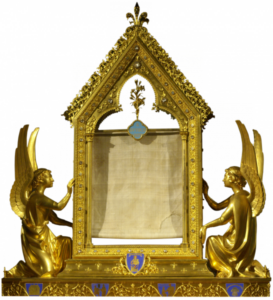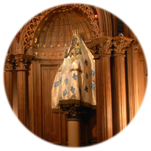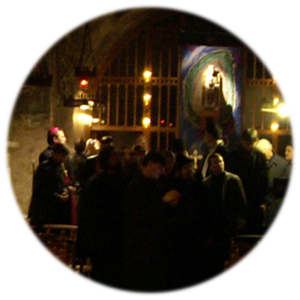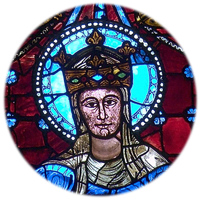YOU ALSO, alone, with your family, with friends,
COME AND PRAY AT NOTRE-DAME DE CHARTRES
More than 80,000 individual pilgrims come to Chartres Cathedral,
each year, to bring your intentions to the Virgin Mary.
But among you, who come as ‘tourists’, how many of you give your visit an authentic spiritual dimension?
There are many of you, if we are to believe the lit night-lights, which reveal the joys and sorrows of life – or sincere thoughts for those who are close to you.
All of you who are sensitive to the spirituality of Chartres, we welcome you with joy.
WHERE?
Four places to meet Mary and her son:
THE VEIL OF THE VIRGIN

To meditate, through its transparency, on the mystery of the Incarnation: Mary of Nazareth saying yes to the angel of the Lord, God becoming man – taking on flesh – in the womb of a young woman from Palestine.
Offered to Chartres in 876 by the king of France, the Veil of the Virgin comes from Constantinople.
Considered one of the major relics of Christ, since it would have touched him on the day of his birth, one of the most precious objects in the West was for centuries locked inside a casket covered with gold and jewels.
It was only later that it was discovered that it was a long head garment – not a ‘shirt’ as it appeared on the seal of the cathedral chapter. Although it was torn apart during the Terror (1793), several fragments – including one particularly important one – were returned to the cathedral in the following decades. Its monstrance reliquary, made by the goldsmith Poussielgue-Rusand, dates from the millennium – 1876.
OUR LADY OF THE PILLAR

Mary who welcomes the prayers of men and women. People come from all over the world to entrust her with their joys and sufferings – for her to hand over to her son: loved ones faced with illness, pain in the face of death, people who are passionately loved, moments of depression, the joy of having a child…
This beautiful pear tree statue, with gilding highlights, dates from 1500-1507.
It was installed to meet the needs of the faithful, who were advancing too far into the choir where services were celebrated. Its donor was Canon Wastin des Feugerets. Initially placed at the crossing of the transept, it was not moved to its present location, in the north ambulatory, until 1806. Pope Pius IX decided to have it crowned on May 31, 1855, which led to a revival of Marian devotion throughout France.
NOTRE-DAME DE SOUS-TERRE

In the crypt, it is the immemorial statue of pilgrimages. The chapel of Notre-Dame de Sous-Terre, with its extreme sobriety, leads irresistibly to this small figure of Mary – who keeps her eyes closed. In the intimacy that so pleased Huysmans, one can stop and listen to one’s heart. A mass is celebrated every day at 11:45.
The present statue dates from 1975.
It is a copy of the old Romanesque Virgin, made of dark oak, which disappeared during the Revolution. Numerous legends were attached to the ‘virgin to give birth’ – that the Celtic priests would have prayed to before the birth of the savior. This mythology, which we know today has no historical basis, has deeply marked the imagination of Chartres, attracting kings of France (Louis XIV), spirituals (Vincent de Paul, François de Sales) and contributing to make this small underground chapel, from the reinstallation of the cult, in 1857, one of the most important Marian shrines.
NOTRE-DAME DE LA BELLE-VERRIÈRE

One of the most beautiful works of universal art is also a place of fervent prayer. The diaphanous blue of the stainless cobalt does not fail to fascinate. On the book that Jesus carries: “Every valley will be filled”. Around it, a dizzying theological construction: Tabernacle within which the divine presence is expressed, Image of the Church, Woman of the Apocalypse, Subject of praise of the heavenly court. At her feet, the scenes of the banquet of Cana, where she addresses humanity: “Do whatever he tells you”.
The panels of the 12th century, representing the Virgin in majesty, are a true mystique of stained glass: pouring the light of the sun – God – into the hearts of the faithful while illuminating them (Durand de Mende – circa 1260).
They may come from the cathedral’s axial window – preserved during the fire of 1194. The thirteenth century panels use a stronger, more opaque blue in contrast. Notre-Dame de la Belle-Verrière, by its capacity to evoke transcendence, is present in the work of many writers: Proust, Malraux, Claudel, Gide, Zweig, Hugo, Rilke.